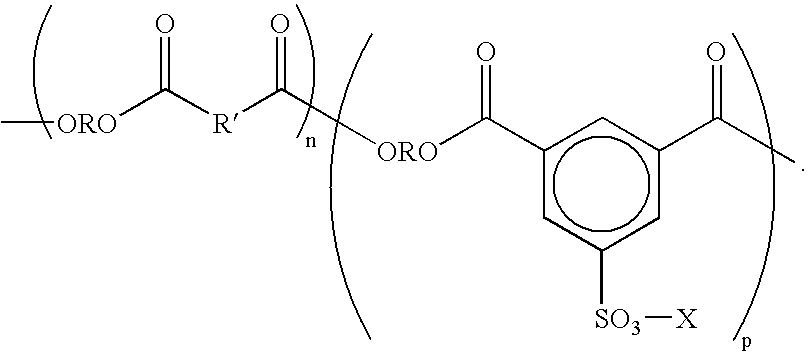Control of particle growth with complexing agents
a technology of complexing agents and growth factors, applied in the field of controlling particle growth, can solve the problems of additional uncontrolled particle growth and difficult control of particle size growth, and achieve the effect of increasing control over the process
- Summary
- Abstract
- Description
- Claims
- Application Information
AI Technical Summary
Benefits of technology
Problems solved by technology
Method used
Image
Examples
example 1
[0057]In a 2 L Nalgene beaker, 531.6 grams of 18 percent by weight of the branched 1.5% lithio-sulfonated polyester resin (Tg=61.1° C.) and 237.2 grams of 10.6 percent by weight of the crystalline 1.5% lithio-sulfonated polyester resin, both emulsified via a solvent flashing method with acetone, were mixed together. To this was added 61.0 grams of 20.7 percent by weight of a Carnauba wax dispersion, as well as 31.7 grams of a cyan pigment dispersion containing 26.5 percent by weight of Pigment Blue 15:3 (made with Neogen RK surfactant). An additional 399.3 g of deionized water was added to the slurry making the overall toner solids in the final slurry to equal 10.26%. After uniform mixing, the pH of the slurry was measured to be 4.84 and was not adjusted. The 3.0% wt. zinc acetate dehydrate solution (3.57 g zinc acetate dehydrate in 112.6 g deionized water), which was adjusted from pH 6.7 to 4.25 with 4.34 g concentrated acetic acid, was added at ambient temperature via a peristalti...
example 2
[0059]In a 2 L Nalgene beaker, 529.8 grams of 18 percent by weight of the branched 1.5% lithio-sulfonated polyester resin (Tg=61.1° C.) and 201.0 grams of 11.8 percent by weight of the crystalline 1.5% lithio-sulfonated polyester resin, both emulsified via the solvent flashing method with acetone, were mixed together. To this was added 61.0 grams of 20.7 percent by weight of a Carnauba wax dispersion, as well as 31.7 grams of a cyan pigment (Cyan 15:3). An additional 507.1 g of deionized water was added to the slurry making the overall toner solids in the final slurry to equal 9.96%. After uniform mixing, the pH of the slurry was measured to be 4.79 and was not adjusted. The 2.0% wt. zinc acetate dehydrate solution (2.38 g zinc acetate dehydrate in 70.7 g deionized water), which was adjusted from pH 6.78 to 4.42 with 1.97 g concentrated acetic acid, was added at ambient temperature via a peristaltic pump over 10 minutes to the pre-toner slurry while homogenizing the slurry with an I...
example 3
[0061]In a 2 L Nalgene beaker, 529.8 grams of 18 percent by weight of the branched 1.5% lithio-sulfonated polyester resin (Tg=61.1° C.) and 201.0 grams of 11.8 percent by weight of the crystalline 1.5% lithio-sulfonated polyester resin, both emulsified via the solvent flashing method with acetone, were mixed together. To this was added 61.0 grams of 20.7 percent by weight of a Camauba wax dispersion, as well as 31.7 grams of a cyan pigment dispersion containing 26.5 percent by weight of Pigment Blue 15:3 (made with Neogen RK surfactant). An additional 396 g of deionized water was added to the slurry making the overall toner solids in the final slurry to equal 11%. After uniform mixing, the pH of the slurry was measured and adjusted from 4.80 to 4.0 with 0.39 grams of concentrated acetic acid. The 1.0% wt. zinc acetate dehydrate solution (1.19 g zinc acetate dehydrate in 50 g deionized water), which was adjusted from pH 6.87 to 4.03 with 2.71 g concentrated acetic acid, was added at ...
PUM
| Property | Measurement | Unit |
|---|---|---|
| particle size | aaaaa | aaaaa |
| particle sizes | aaaaa | aaaaa |
| particle sizes | aaaaa | aaaaa |
Abstract
Description
Claims
Application Information
 Login to View More
Login to View More - R&D
- Intellectual Property
- Life Sciences
- Materials
- Tech Scout
- Unparalleled Data Quality
- Higher Quality Content
- 60% Fewer Hallucinations
Browse by: Latest US Patents, China's latest patents, Technical Efficacy Thesaurus, Application Domain, Technology Topic, Popular Technical Reports.
© 2025 PatSnap. All rights reserved.Legal|Privacy policy|Modern Slavery Act Transparency Statement|Sitemap|About US| Contact US: help@patsnap.com

